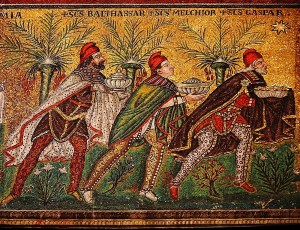“After Jesus was born in Bethlehem in Judea, during the time of King Herod, Magi from the east came to Jerusalem and asked, ‘Where is the one who has been born King of the Jews? We saw his star in the East and have come to worship him.’ ” Matthew 2:1-2.
 The Three Wise Men have been written into history for following a star are as much a mystery as is exactly what it was they saw over 2,000 years ago: A mystery upon which modern day scholars and astronomers are working to shed light.
The Three Wise Men have been written into history for following a star are as much a mystery as is exactly what it was they saw over 2,000 years ago: A mystery upon which modern day scholars and astronomers are working to shed light.
In all likelihood, these Magi were Zoroastrian priests following the star from the eastern Babylonian settlement.
Many cultures looked to the stars for direction—not just horoscope type of stuff—the wise men may have been Zoroastrians, from a culture that paid a great deal of attention to the stars—stars doing something meant the gods were doing something.
Though eastern cultures paid particular attention to the movement of the stars, few Jews lent similar credence to the celestial patterns, according to Rabbi Joe Blair.
“Judaism generally rejects the validity of astrology—this whole focus on stars, alignments, signs, etc., is outside normative Judaism,” he explains.
Be that as it may, the Magi moved west in pursuit of a celestial sign and set off a chain of events, culminating in the establishment of one of the world’s largest religions.
But was this sign actually a star? The Magi’s careful study of astrology would lead one to assume that the birth of a simple star would not set such a massive undertaking into motion.
According to modern day astronomers, these Zoroastrians would most certainly have noticed a compelling sign in the sky, but what could give impetus to a months-long journey over treacherous terrain?
Was it a comet? A nova? A supernova? A massive meteorite? An alignment of the planets? Or something else?
For many cultures of the era, changes in the heavens predicted and defined earthly events. These changes were viewed as divine messages, imparted from the gods to humans on Earth.
And for these Magi, this sign heralded the birth of an incredibly important figure in the land of the Jews.
The star was recorded as the heavens were announcing the birth of this child. These Magi were unsure of just what it was they saw, as are scholars today.
Regardless, the iconic image of a bright ball of light hovering over a babe, wrapped in swaddling clothes and lying in a manger, surrounded by his virgin mother, his carpenter father and the shepherds from the fields has become as much a part of Christmas Story as the gifts we give to each other at this special time.
Gifts that, arguably, commemorate those presented to the baby Jesus by these same wise men.
Gold for a king, incense as a special spice used in the worship of gods, and myrrh as a gift for death.
What it was, why they followed it—there are many questions surrounding both the wise men and the object of their fascination, but there is one answer that cannot be challenged: Their actions set in motion a chain of events still felt today.
A truly miraculous event doesn’t need a scientific explanation . . . the legacy of the Christmas Story is peace on Earth and goodwill to everyone.














While the Rabbi may have one opinion regarding stars I refer you to a book called The Syrian Christ by Abraham Mitrie Rihbany, a Syrian Christian immigrant who wrote a book in 1917. At that time, he felt that in his homeland, things had not changed much since the time of Christ. He devotes a while chapter to the star and how stars held a great place in their society. Rewrites of this 1917 book are available new and used.